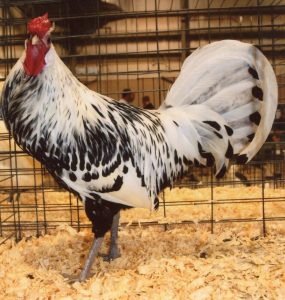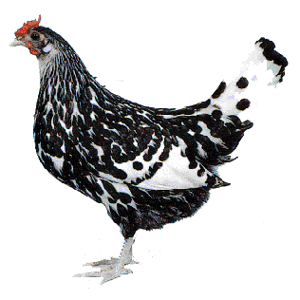
Breed Overview
Hamburg Chickens are a very old race of domesticated poultry. The name of the breed is German, but it is believed they originate from either Holland or Turkey.
Hamburg Chickens owe their present shape and color qualities to the British fanciers, who, over a century ago, began the work of refining the ‘pheasant fowls’ of that period into modern Hamburgs. The Spangled type, was kept in Yorkshire and Lancashire three hundred years ago.
Also a breed called Black Pheasants was mentioned in a book of 1702. The name Moonies originates from the Moon shape spangles on the feathers. There is mention of them in Thomas Hardy’s book ‘Tess of the D’urbavilles’ The Black and Spangled varieties were created in England; the Penciled varieties came from Holland via Hamburg, Germany.
Males weigh on average 5lbs (2.25kgs) and females weigh 4lbs (1.8kgs).
Eggs
Size
Medium size eggs
Color
White eggs color
Production per year
200 eggs per annum
When do they start laying eggs?
From 16 weeks
Hamburg Characteristics
Temperament / Are they good as pets?
They are fairly hard to tame but are still known for being friendly. They can become aggressive if they don’t have enough space or are bored of their environment.
How do I tame Hamburg chickens?
The best way to tame chickens is to hold them whilst they are still chicks in order to get them used to human contact. If you have got older chickens you can try and feed them right out of the palm of your hand in order to tame them.
How many do I need to buy?
You should always have at least 2 chickens in a coop as they get lonely if they are by themselves. Ideally a small flock should be around 6 chickens.
How much space do they need?
This breed is happier free range. This means they need at least 250 square feet per chicken.
Will they mix with my other chickens?
Hamburg chickens are known for being really friendly and should mix well with any other chickens, so long as they have lots of space.
Appearance
They have blueish gray legs that have no feathers on them and a long tail and big wings. They have small red rose combs and red eyes. There are lots of different color varieties, 6 of which are recognized by the American Poultry Association. The most common color of plumage is silver-spangled, which are white feathers with black tips.
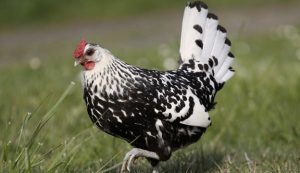
Feeding
What should I feed them?
You should feed them growers mash when your chicks first hatch. This has 19{cfcd481556a8b43fba6af451761032bd323e94372a0c1e607} protein content and all the good stuff your chicks need to grow big and strong.
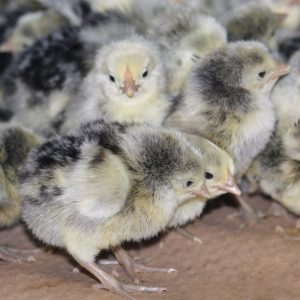
At 6 weeks they can be switched to standard chicken pellets which is just a pellet form of chicken feed, usually contain 15-16{cfcd481556a8b43fba6af451761032bd323e94372a0c1e607} protein.
At 14 weeks you should gradually introduce layers mash or layers pellets. This has around 16{cfcd481556a8b43fba6af451761032bd323e94372a0c1e607} protein and has everything you girls need to help the make eggs.
How much should I feed them?
The average chicken eats ¼ of a pound (113g) of feed a day. If you give them this to start off with you can check how much of this they’ve eaten and then change the amount based on this. You can either give them the food during mealtimes or leave feed in the feeder for them to nibble on as they please.
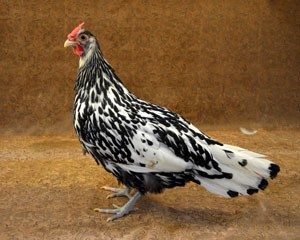
What can’t they eat?
On the feed section of our page you’ll find an extensive list of what chickens can’t eat. Chocolate and beans are the most notable things that should be kept far away from chickens. This is because they contain theobromine and phytohemagglutinin which can be deadly if ingested.
Any food that has grown mold or has gone off shouldn’t be given to chickens as it can potentially cause health problems.
What do I need to keep chickens?
The first thing you should think about getting when planning for your chickens is a coop. The coop should be 11 square feet per chicken and have a perch for each chicken inside which they can rest their feet on at night.
Laying boxes are also needed for them to lay their eggs in, these should be wooden and you can fill them with wood shavings. To keep your chickens safe from any predators you need a fence around the vicinity and over the top of the coop which is sunken into the ground to prevent them from digging under the fence to access the coop.
Hamburg chickens are happiest when they are kept as free range chicken; therefore, you need at least 250 square feet of extra space outside of the coop per bird. Your chickens should always have access to water and you need to find a stable container that can take a few soft nudges.
Grit is vital to egg production and if you don’t have any natural grit you need to buy some which they will help themselves to as they please.
